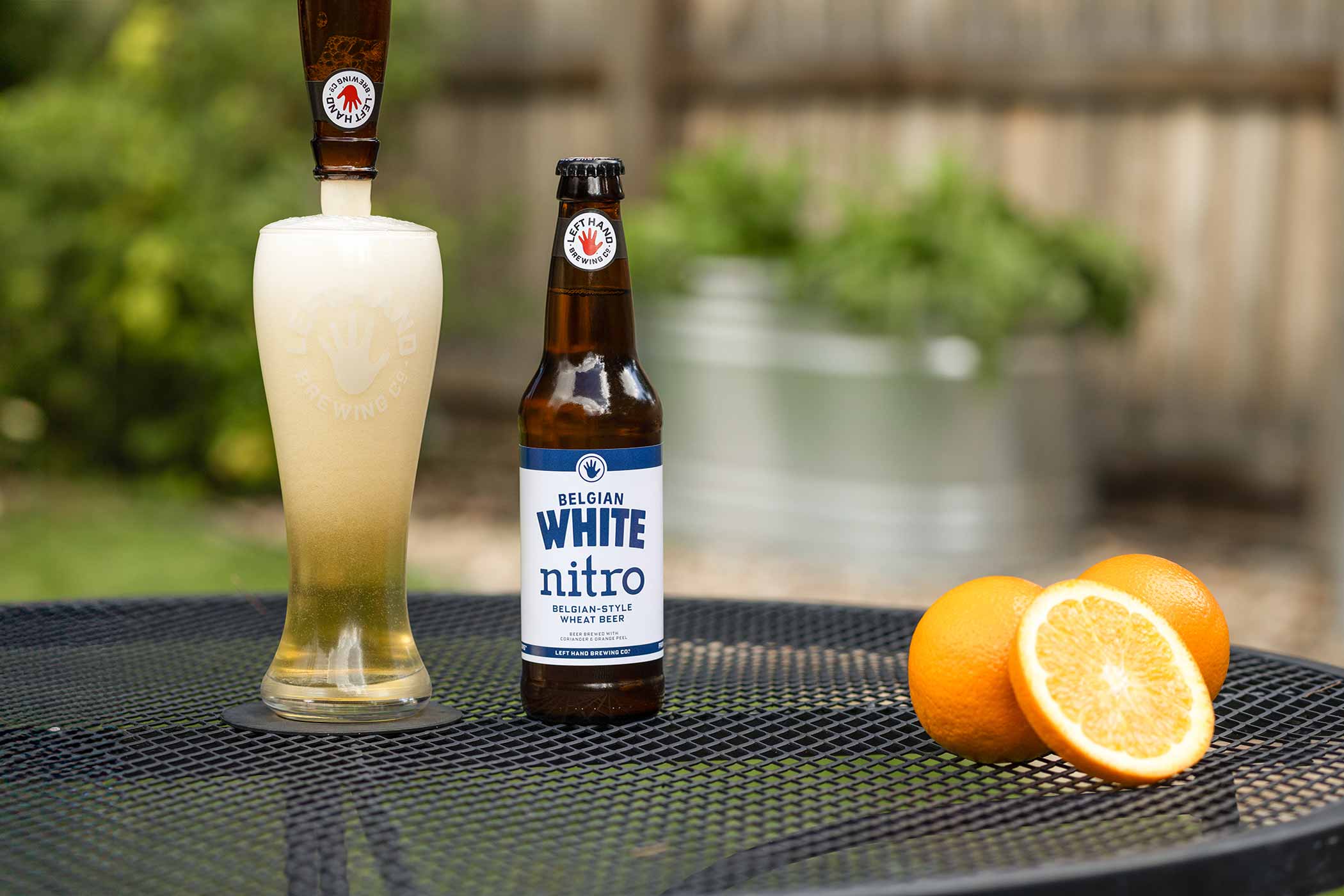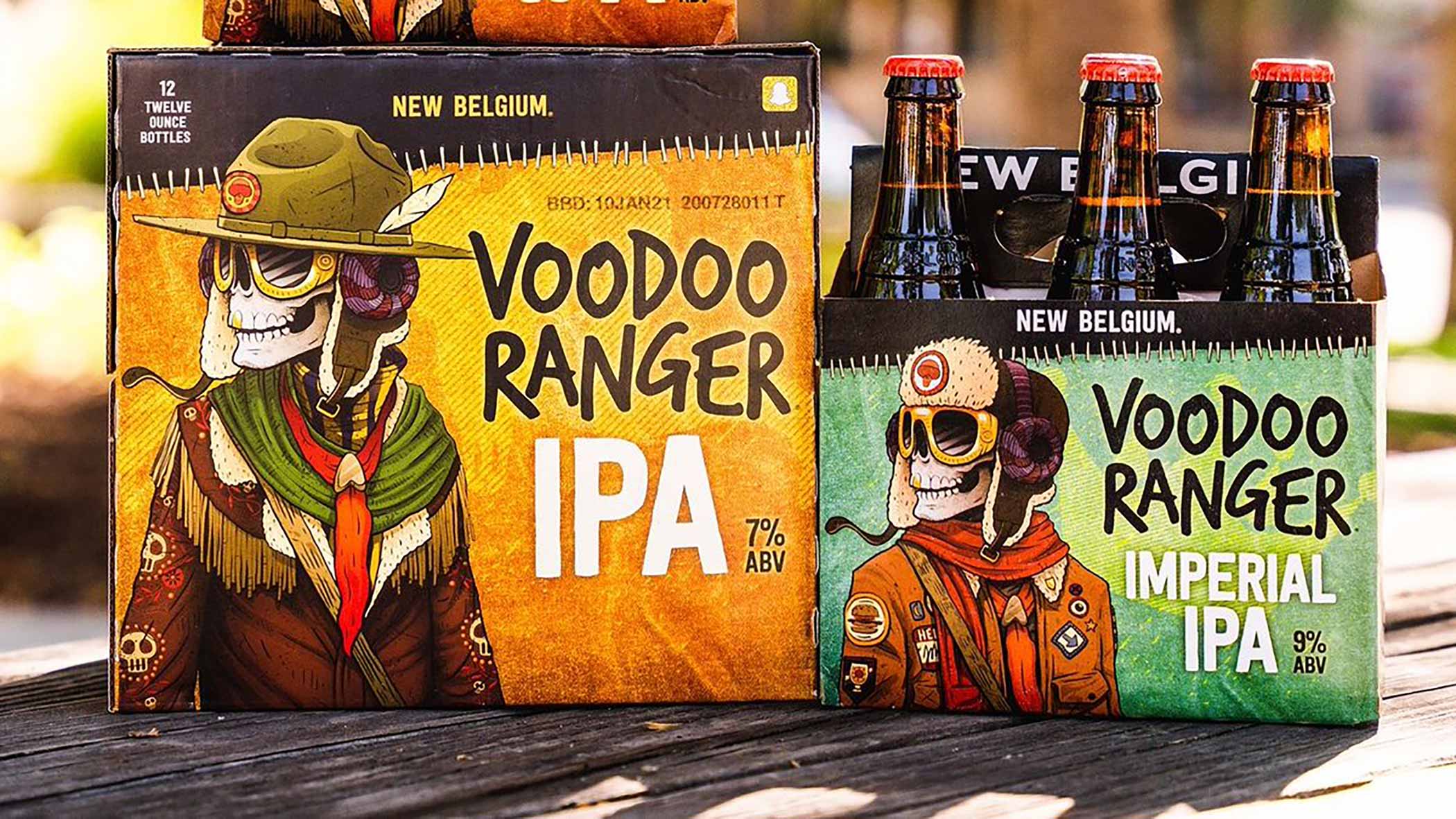Shop
Why Left Hand Believes Its New Nitro Release Will Drink Best in Glass
Pour hard!
Looking for More?
West Coast IPA vs. hazy, higher ABV vs. no ABV, and aluminum cans vs. glass bottles—just some of the most significant debates in craft beer over the last ten years. The latter, in particular, really stands out on the shelf. Seriously, craft beer cans have become the darling of packaging, but let’s not forget that glass bottles in all shapes and sizes used to dominate the beer market.
And for good reason.
Glass beer bottles contain four simple, natural ingredients: silica sand, limestone, soda ash, and recycled glass. It’s 100% recyclable, over and over, and can go from curbside recycling back to the shelves as a new bottle in as little as thirty days.
Glass’ pure ingredients mean it protects the beer inside. It tastes the way the brewery intended—no metallic aftertaste.
Plus, breweries can get glass bottles to market quicker and provide a premium feel you just can’t get in cans.
For all these and more, glass might just be the best packaging for beer.
But don’t just take our word for it.
At Left Hand Brewing Company in Longmont, CO, their Milk Stout Nitro is their number one selling SKU in 6-pack bottles.
When it came time to release an entirely new nitro product, Left Hand turned to…you guessed it—glass bottles.
Has Anyone Ever Made a Belgian White Nitro?
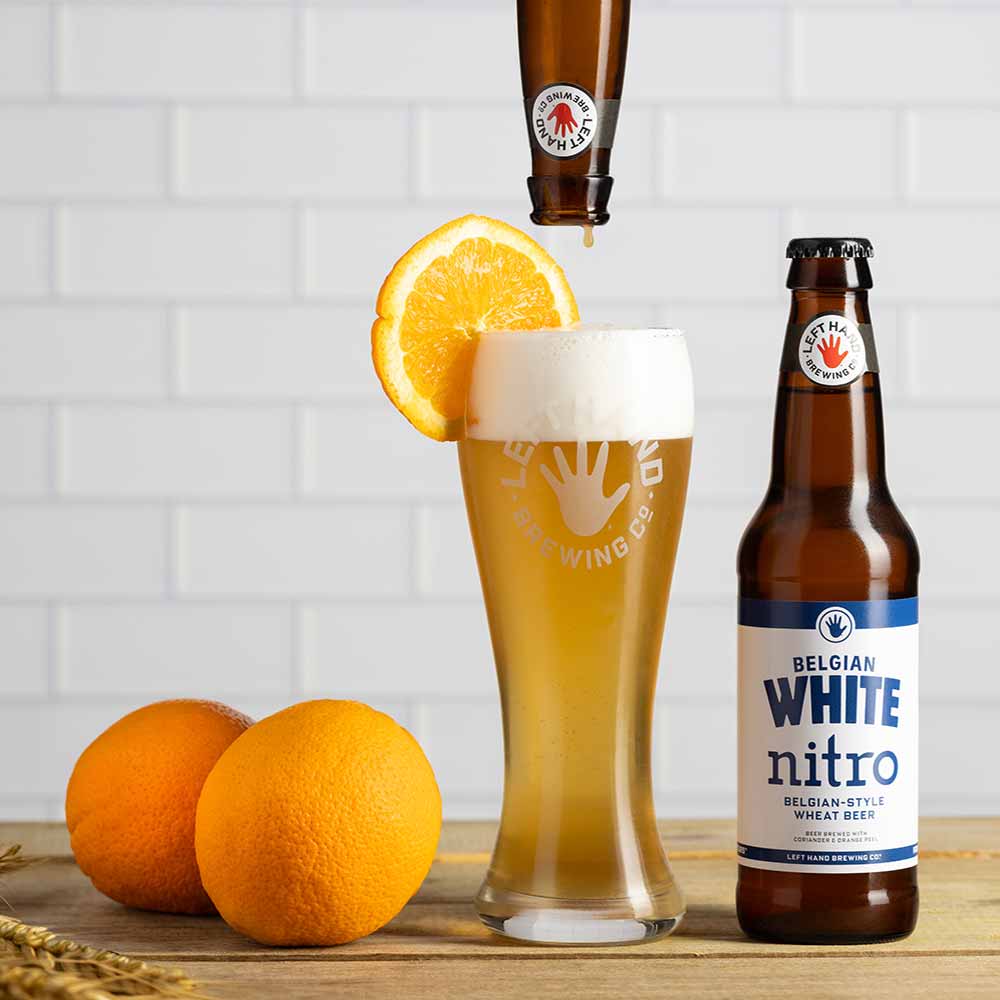
Photography courtesy of Left Hand Brewing Co.
Looking for a new brand to develop with nitro that wasn’t a stout, Left Hand got the idea to apply its nitro-loving ethos to a Belgian witbier from a team member. “I’ll be honest, I was a little skeptical at first,” says Left Hand Head Brewer Gary Glass, noting that these beers are typically highly carbonated, so dropping to little to no carbonation in a nitro treatment seemed tricky. “But we did a few pilot batches and instantly liked the results.”
Glass started with one of his homebrew recipes, piloting and scaling up for production.
“It’s pretty cool that our roots are in homebrewing, and the former boss of the AHA’s [American Homebrewers Association] homebrew recipe is now a year-round perennial for us,” Left Hand Co-Founder Eric Wallace chimes in.
After trying those initial batches, Glass says his original fears dissipated as quickly as fizz in a nitrogenated beer. “When I tasted it, it was really cool because somehow the nitrogen really helped the mouthfeel and kind of held in this deep complexity,” he shares.
This beer also surprised Wallace. “My first impressions were, wow, this thing really, really works!” he says. “This is unbelievable; I was pretty stunned.”
Wallace likens the reaction to the first time someone sees Left Hand Milk Stout Nitro poured into a glass. “We’ve seen so many people push themselves rapidly away from the table because it freaks them [out],” says Wallace, referencing the frothing, cascading effect nitrogen has on a beer when poured hard out of the bottle. “It’s a cool parlor trick.”
But it’s more than a trick. Nitro affects the mouthfeel of the beer, adding this velvety, creamy texture that also impresses.
For that reason, nitro gained popularity for darker styles like stouts and porters. But a Belgian witbier? To our knowledge, not many witbiers on nitro exist.
Without much of a blueprint, Glass needed to carefully consider each step of the recipe.
Similarly, Left Hand thought conscientiously about how they wanted to present their new brand launch to the world.
Making a Splash With Glass
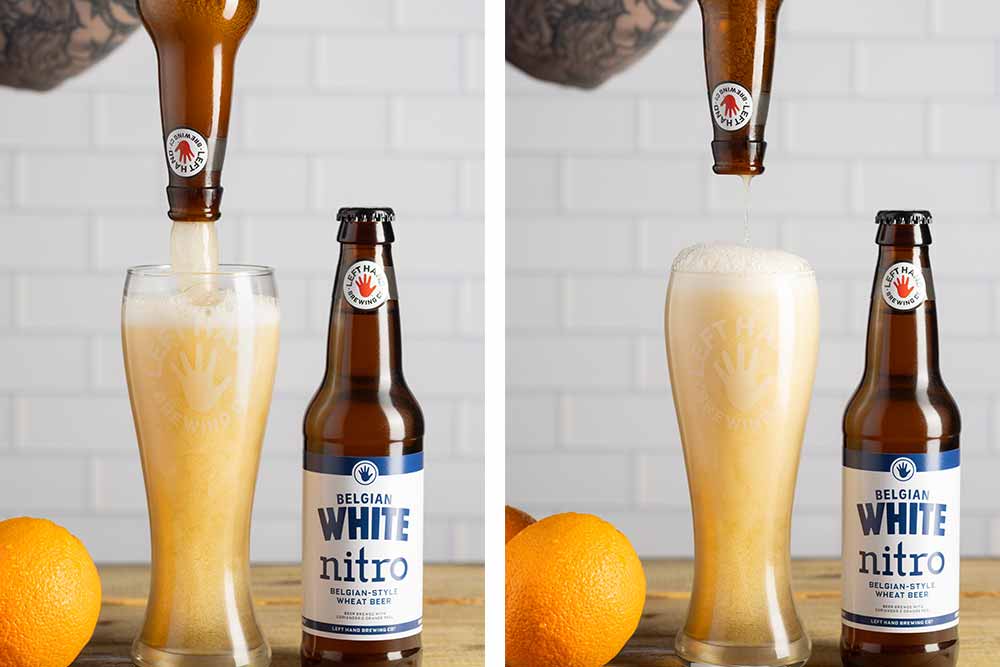
Photography courtesy of Left Hand Brewing Co.
“It is my own personal bias that I think beer should come out of a glass bottle,” shares Wallace. “I think the market has told us all the reasons can is more convenient, but glass is a non-reactive substance; it’s a better vessel, especially for [beer that’s going to be] in a package for a while.”
Wallace points out that logistically and practically, “brewer warehouses across the world and the country are stacked full of empty cans—many of which will never get used for their intended purpose. “Our glass warehouse consists of two forty-five-foot trailers, while our can warehouse has thousands of square feet stacked pretty high,” he says. “It’s just a waste of space.”
Glass adds that Left Hand’s purchasing team always advocates for glass bottles because they’re constantly juggling minimum order quantities and run sizes and playing “Tetris in the warehouse of where everything goes,” he says. “It’s probably hard to imagine how much time we spend discussing that—way too much.”
At the end of the day, Wallace says Left Hand just considers glass to improve the quality of the beer along with its shelf life.
“We have imperial stouts downstairs [in glass bottles], and those things last for years,” he shares. “You can’t do that in a can.”
For all these reasons, glass for Belgian White Nitro felt right.
“Choosing to launch this product in a glass bottle gives consumers the experience they love, especially for the Nitro line of products,” says Alexis Guetzlaff, director of marketing for beer at O-I Glass, creator of the revolutionary Drinktainer™, which disrupts can conformity by providing a unique beverage packaging solution. “We are so excited for the launch of Belgian White Nitro from our long-time partners.”
Glass bottles have played a significant role at Left Hand for a long time. As we mentioned, the brewery’s revolutionary Milk Stout Nitro in glass bottles remains the brewery’s best-selling SKU. “It’s lonely out there on the shelf for a milk stout in a bottle in a store, so it needs some company,” Wallace explains.
Now, retailers can set down a white 6-pack of Belgian White Nitro next to the brewery’s black 6-packs of Milk Stout Nitro.
Glass agrees it was the right decision to release Belgian White Nitro in glass bottles.
“For those of us who have been around long enough, we remember when the consumer of craft beer generally thought a can was a lesser package, shunning it,” he says. “It seems ironic that it has come around the other way, but if I see something in a glass bottle, I have this quality perception of, oh, yeah, that’s a better package for beer.”
The Secret to Making Nitro Belgian Witbier
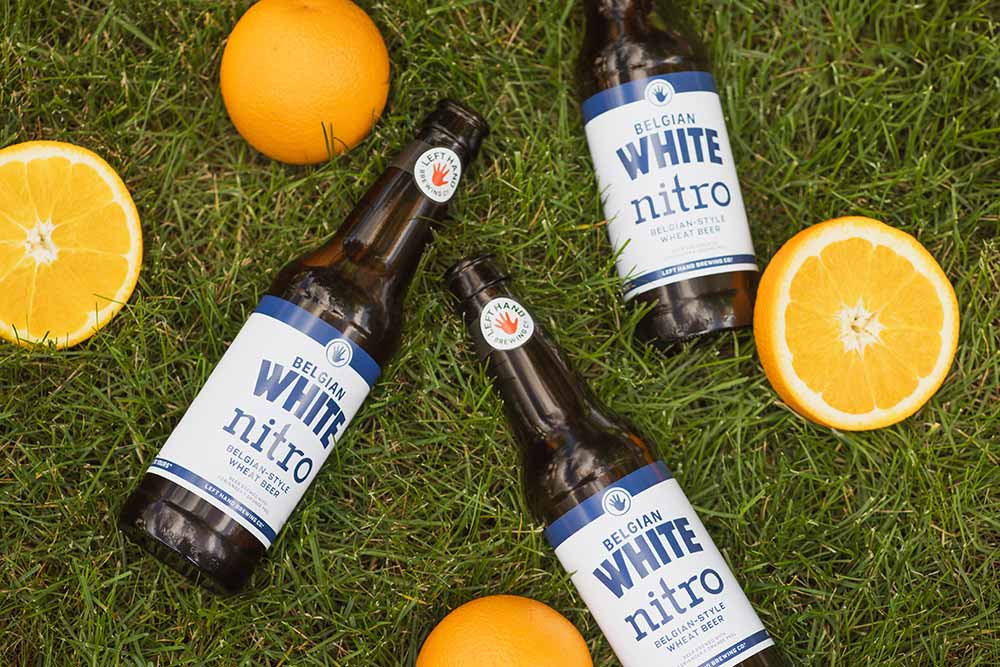
Photography courtesy of Left Hand Brewing Co.
Besides the glass bottle, you mean?
Glass (the brewer, not the bottle!) adds coriander and two types of orange peel to pair with the esters and phenols you’ll get from a Belgian yeast.
“I don’t want you to actually identify any one of those particular things,” says Glass. “I want them all to be harmonious.”
Wallace jumps in, adding, “That’s written on a wall in our hallway: balance. You don’t want to identify everything too obviously; you want it to all meld together.”
Glass emphasizes that the nitro here creates a cap of foam that melds all of those ingredients together. “You get something incredibly flavorful without being assertive for a 4.8% beer packed full of flavor but immensely drinkable,” he says.
Wallace finds the nice bready base to be a great diving board from which you can jump into a pool of complexity with fruity, spicy notes. All popping more thanks to that nitro cap, which “like a Ziploc Bag commercial, locks in the flavor!” says Wallace.
With many nitro offerings on the shelves, either stouts or porters, Belgian White Nitro stands to be a timeless beer that will redefine the idea of nitrogenated beers.
Left Hand Sees Glass As the Future, Not the Past
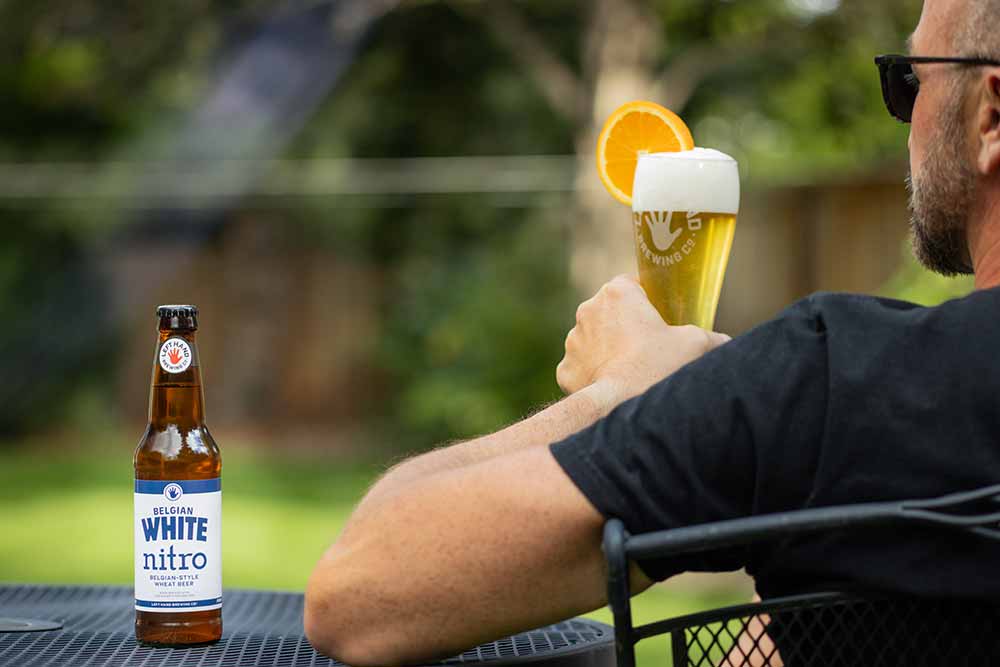
Photography courtesy of Left Hand Brewing Co.
Left Hand has always operated just a little bit differently. The whole ethos of the brewery is to use nitro as “our biggest differentiator to keep pushing out there and trying to get a bit of a stir going,” says Wallace.
Words like status quo and normal need not apply to Left Hand.
So, while most of the industry may be reaching for cans, Left Hand remains committed to using the vessel they feel fits best for beer…and has for a very long time.
“Glass has been around for millennia,” Wallace reminds us. “Let’s talk about how Romans were putting stuff in glass!”
Today, Wallace says it all boils down to what’s the right container for the beer. “We’re going to explore and significantly consider glass as we release new things,” he shares, whether that’s Belgian White Nitro or other projects in the pipeline. “When something new comes out in a perennial package, there will be a thorough debate about it.”
For now, you can find Belgian White Nitro on draft and in only 6-pack 12oz glass bottles throughout Left Hand’s forty-six state footprint.

